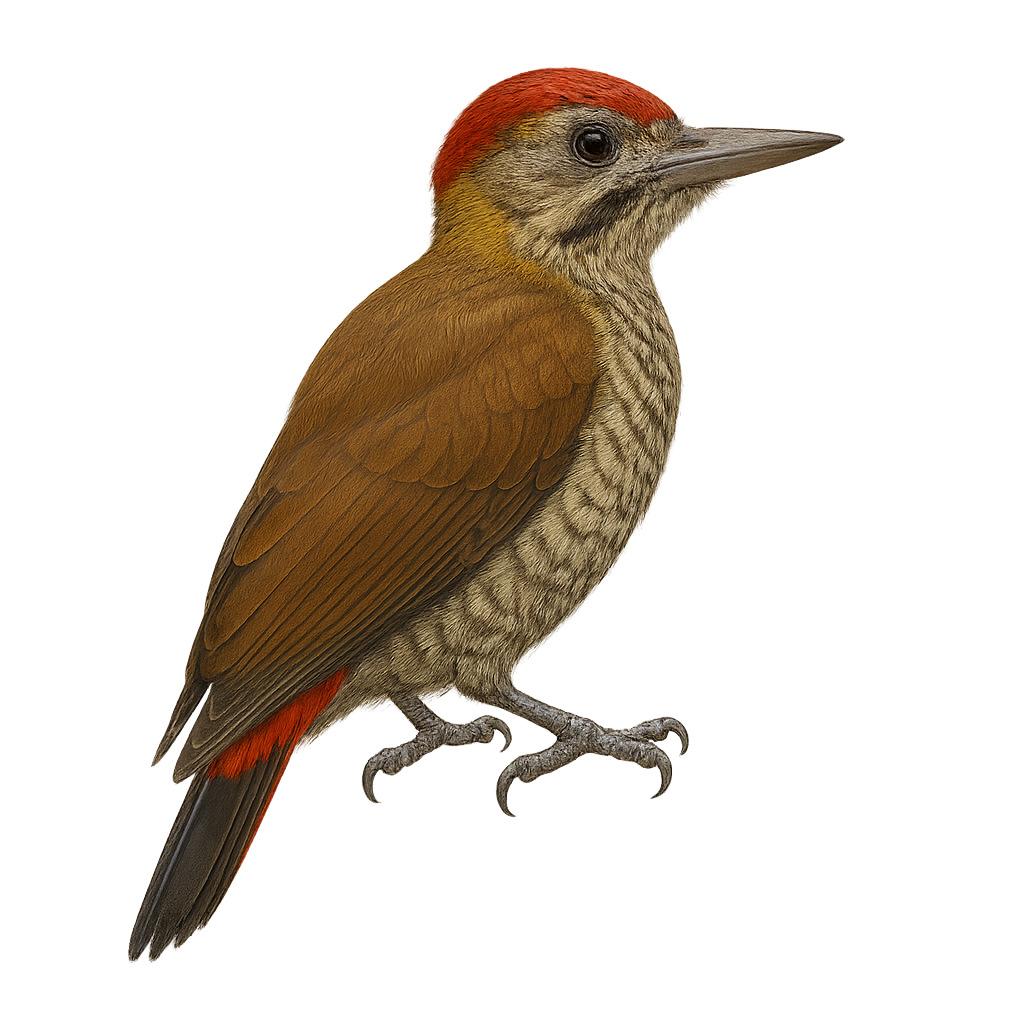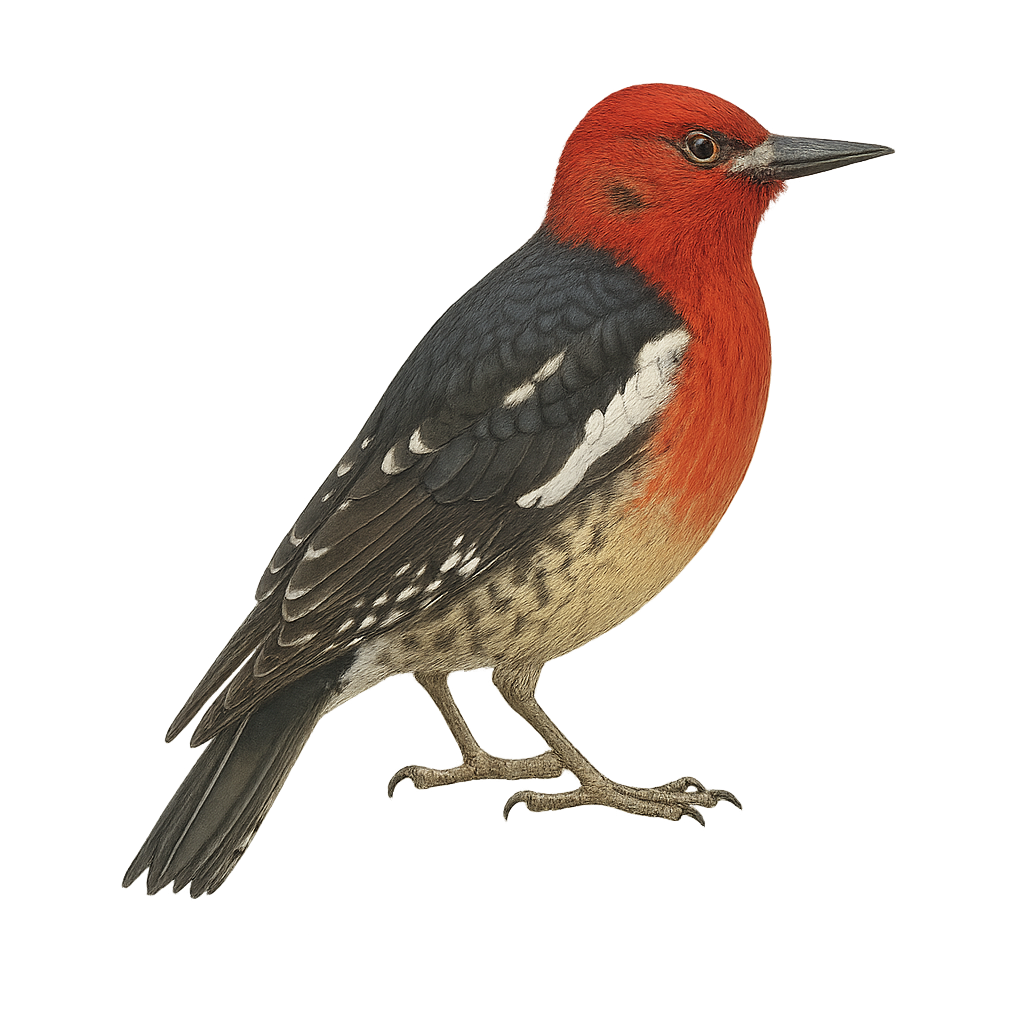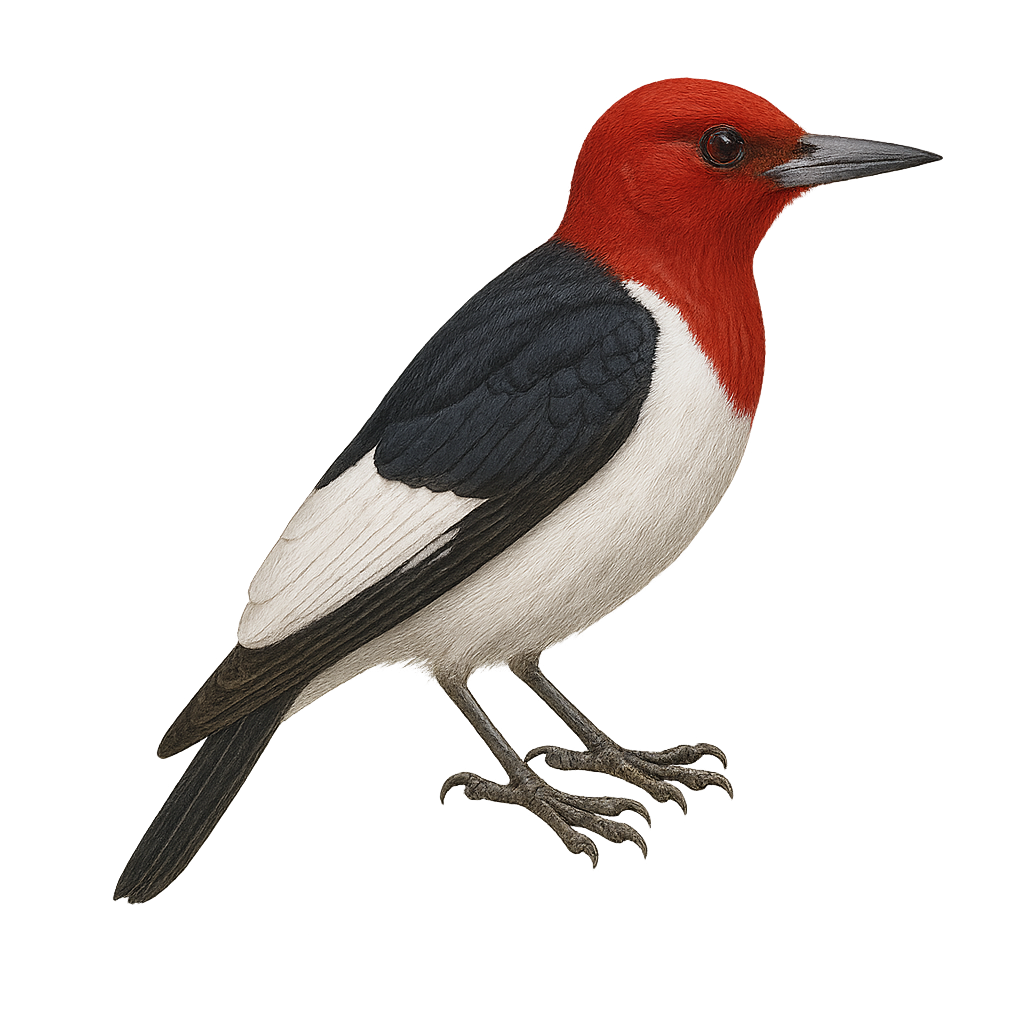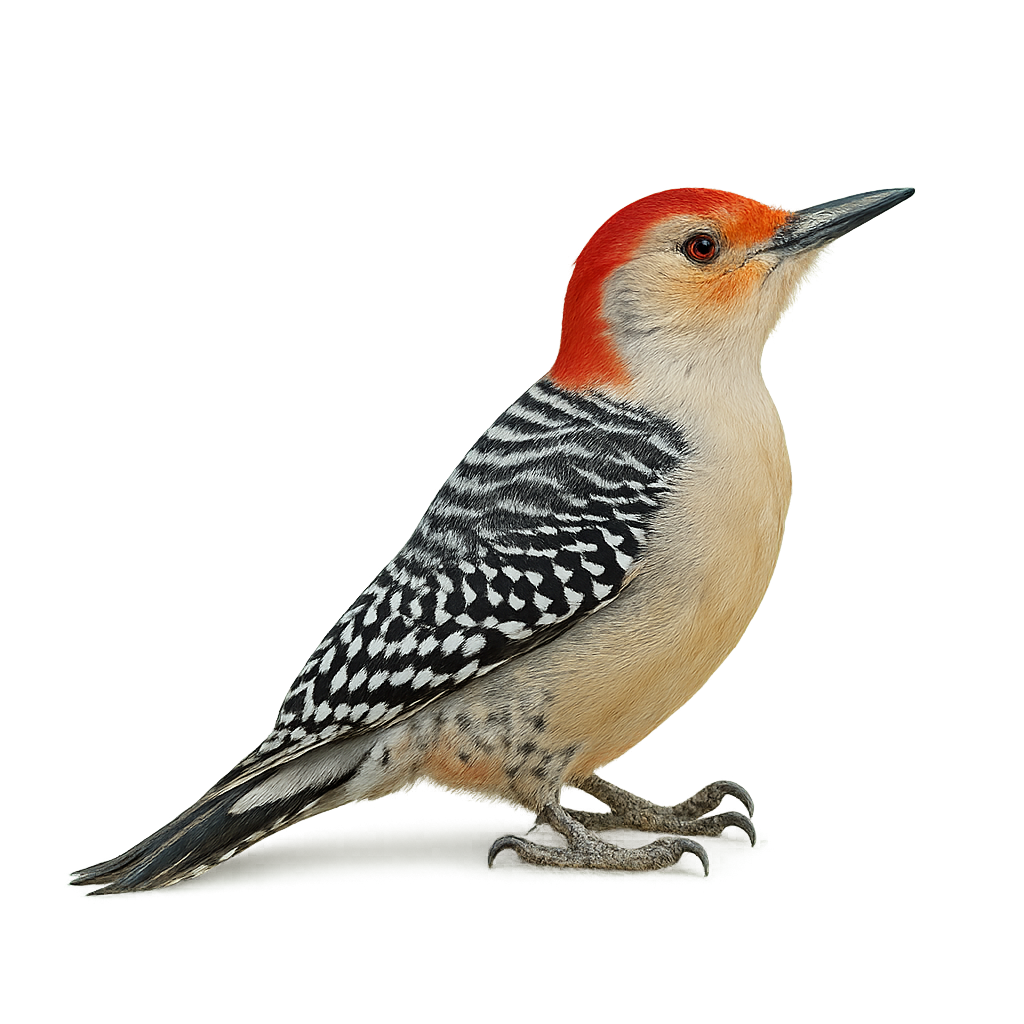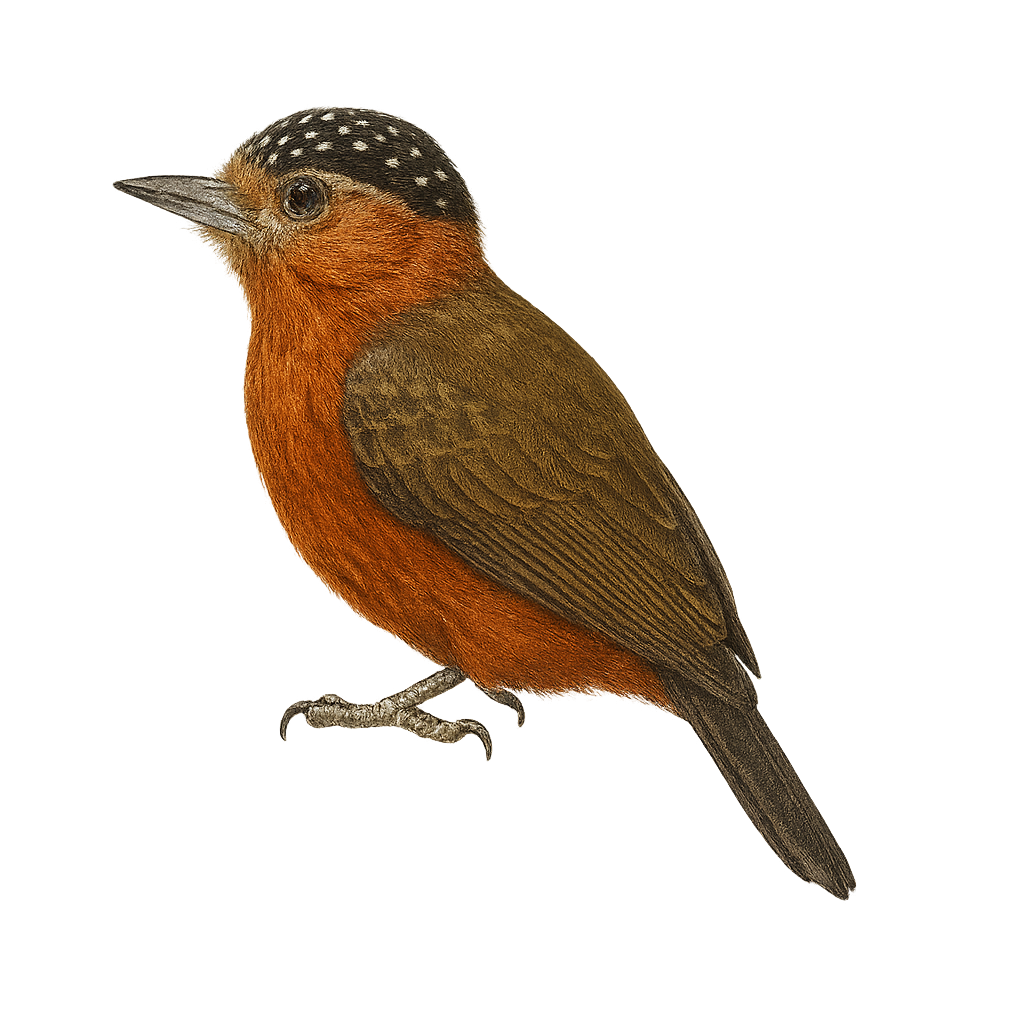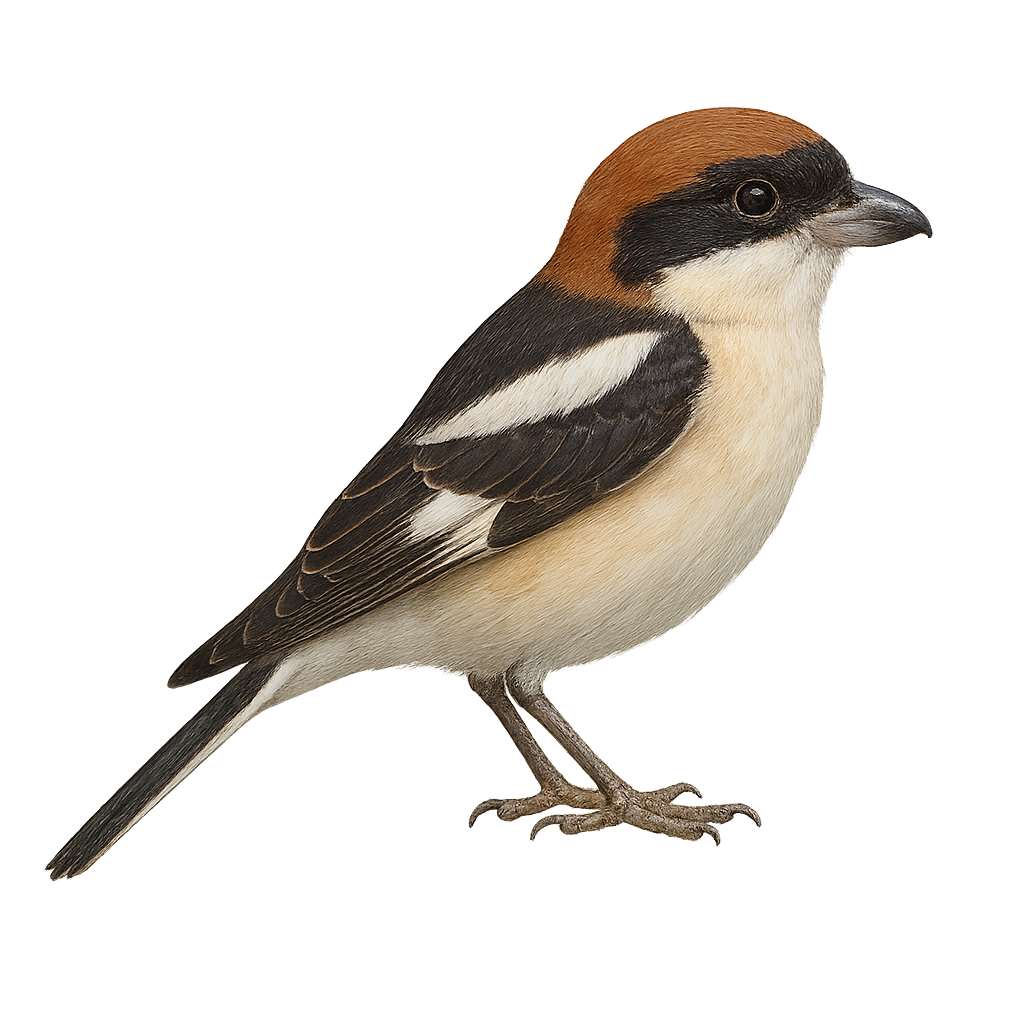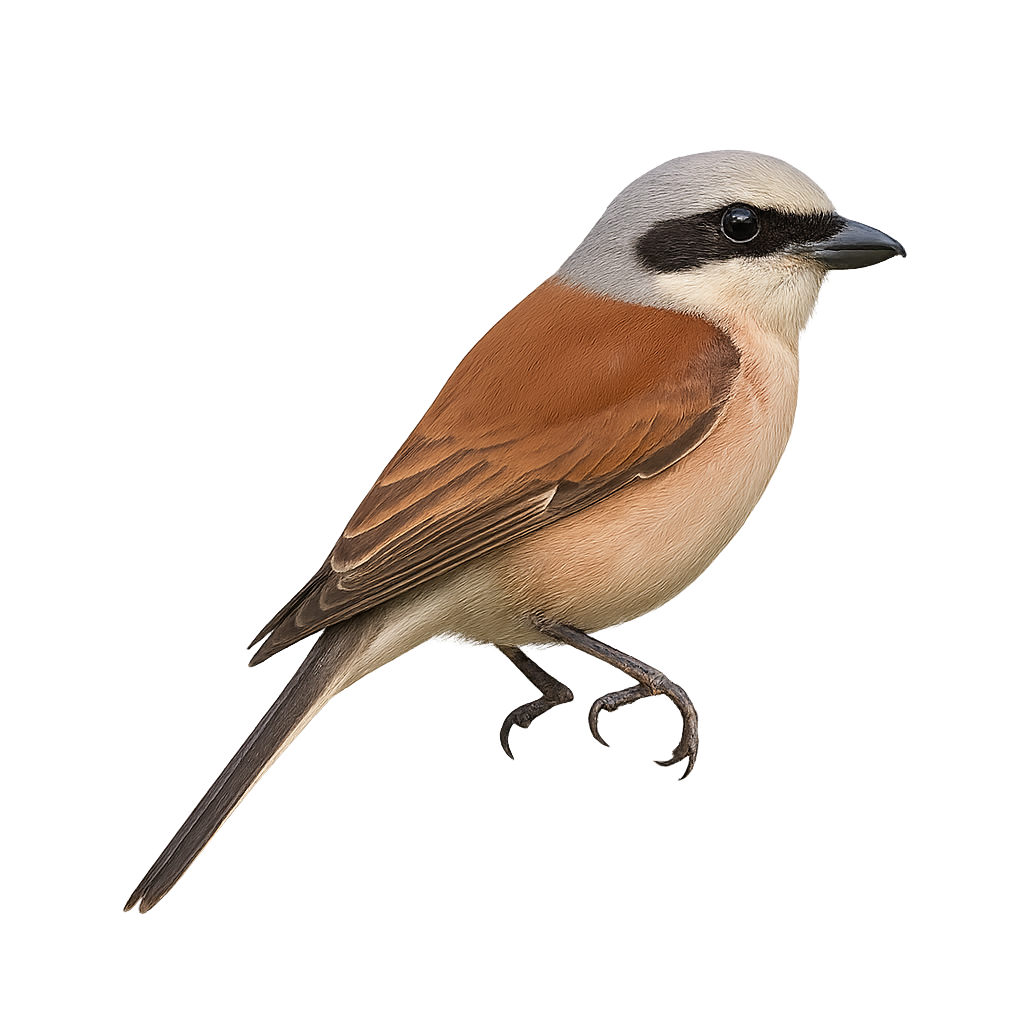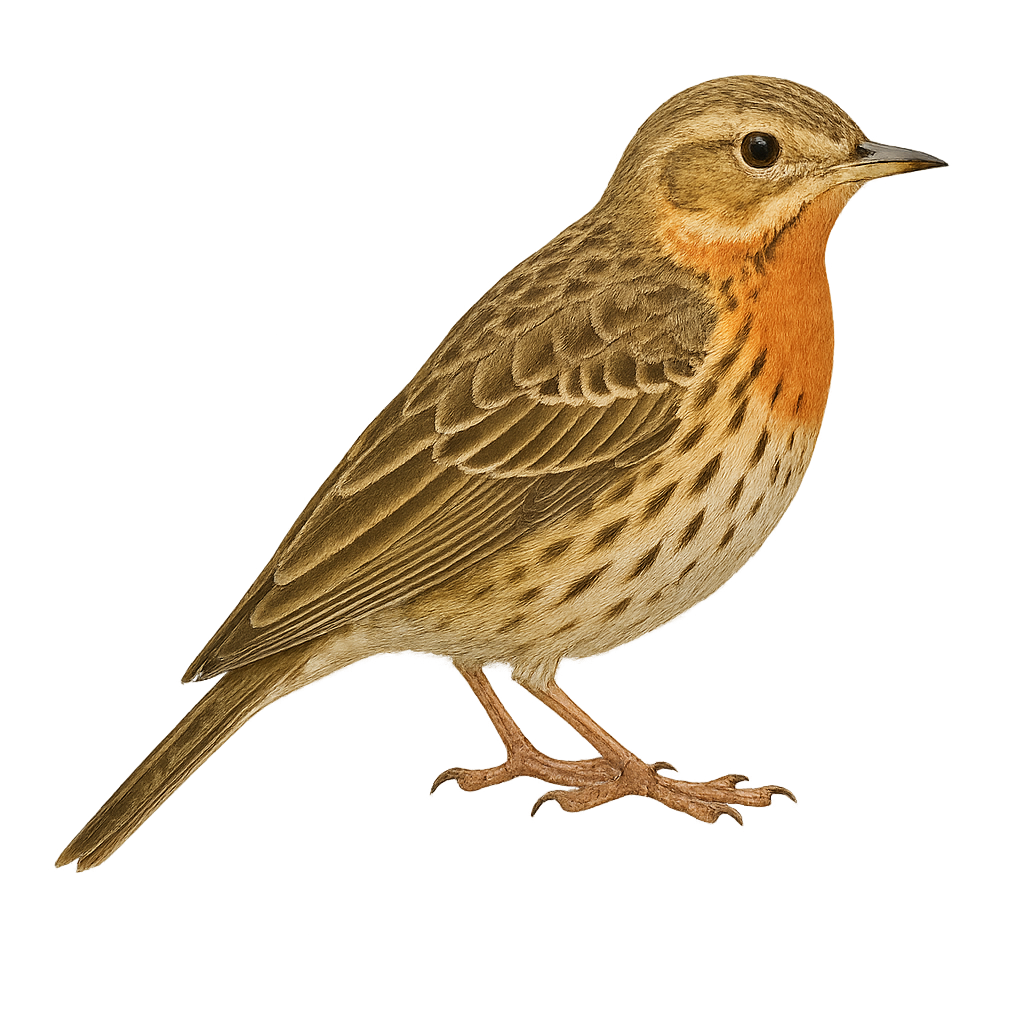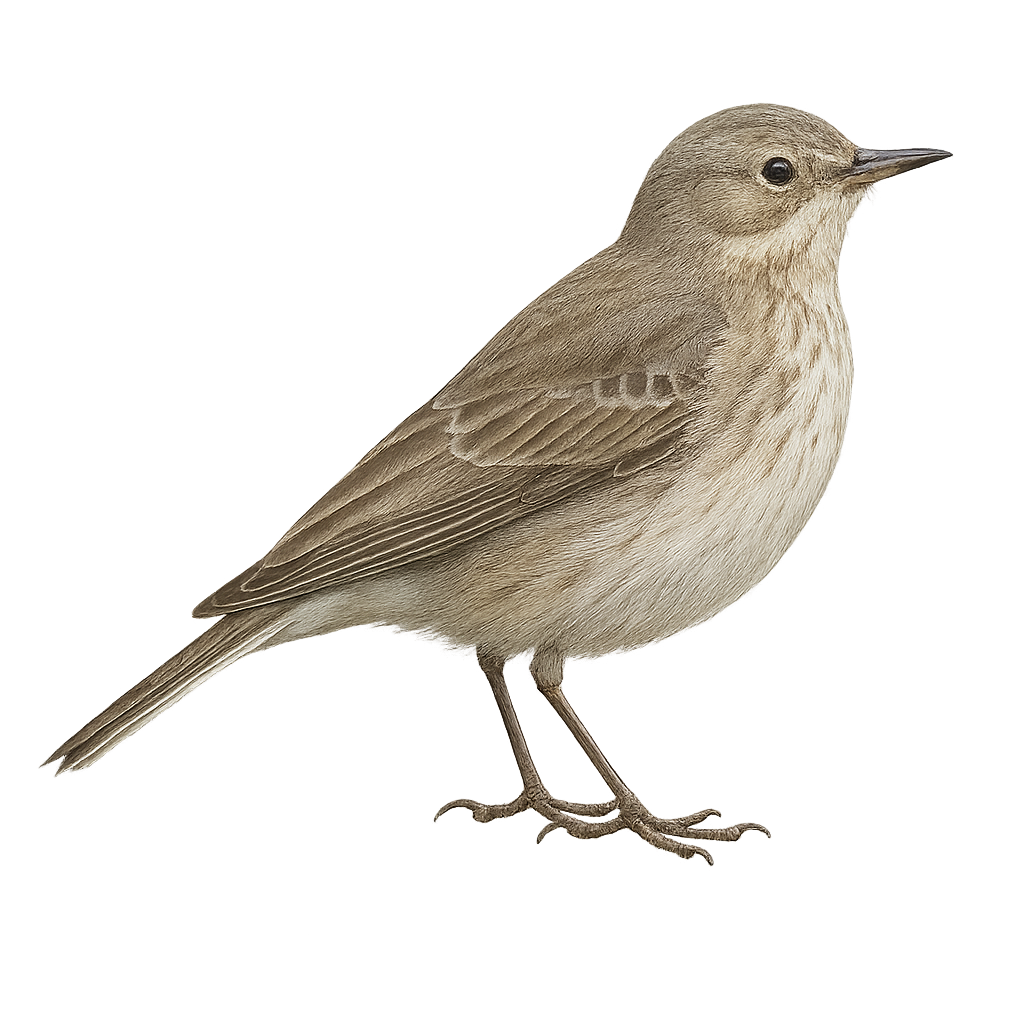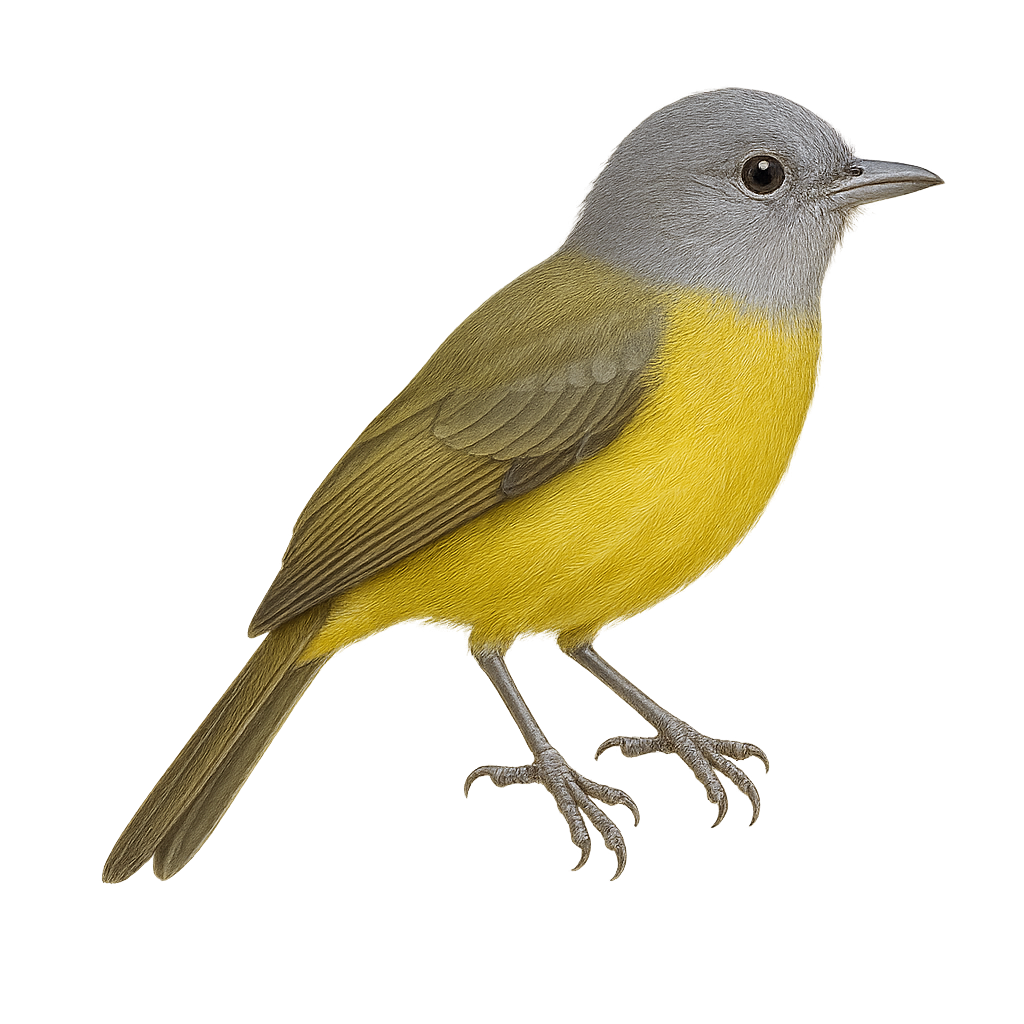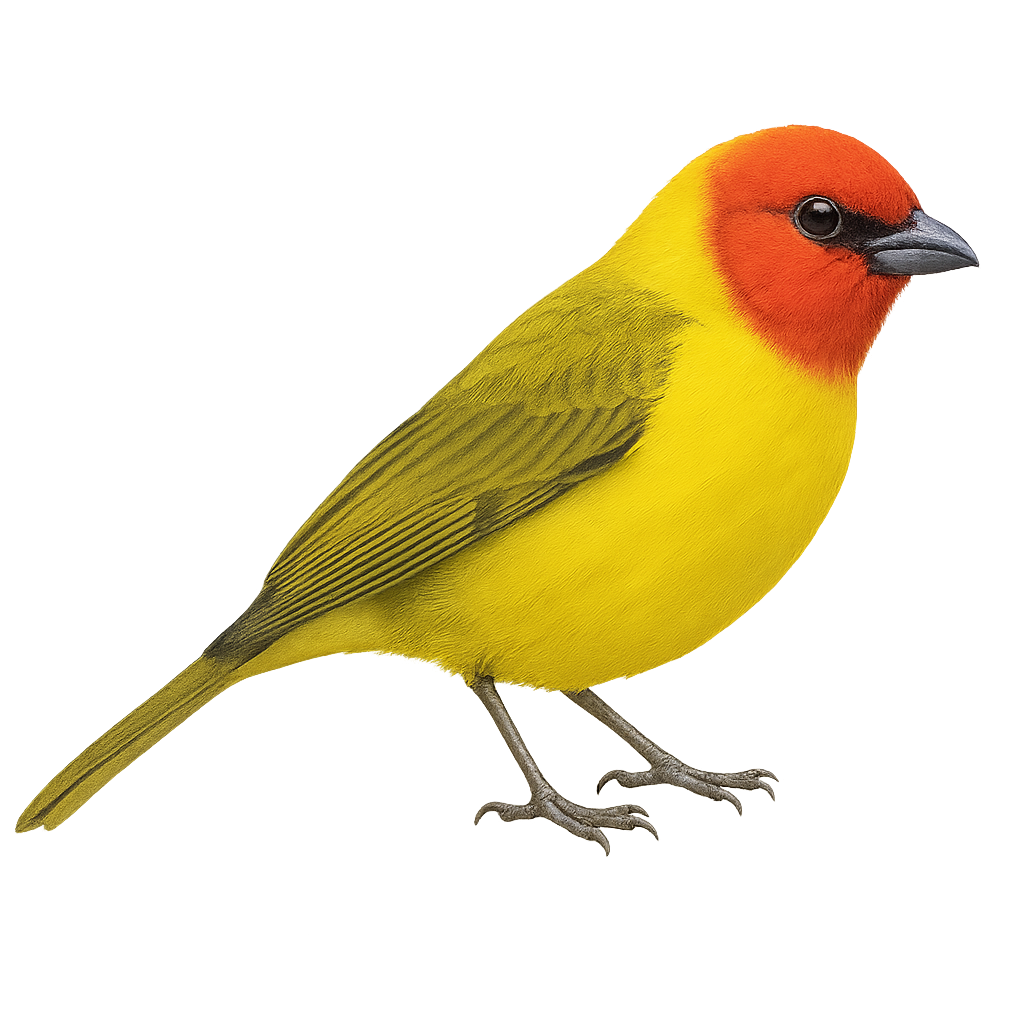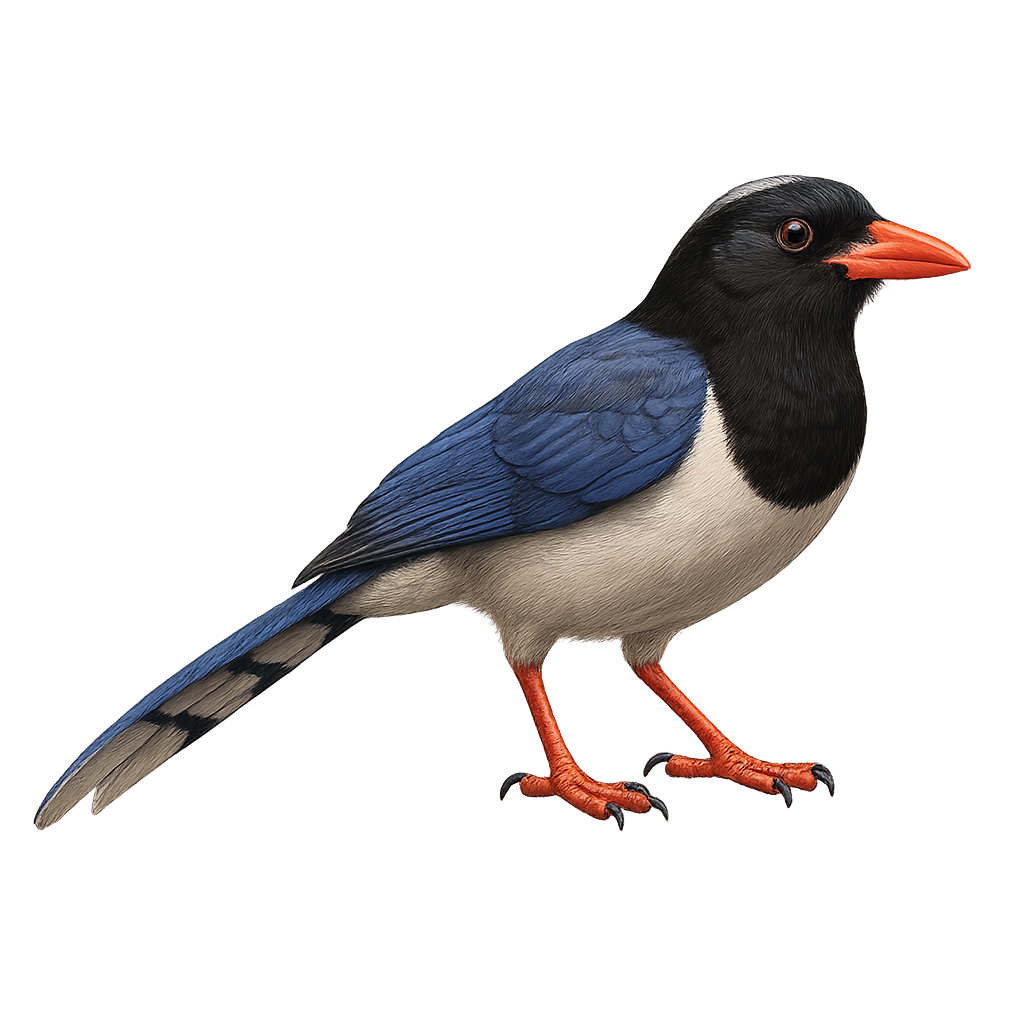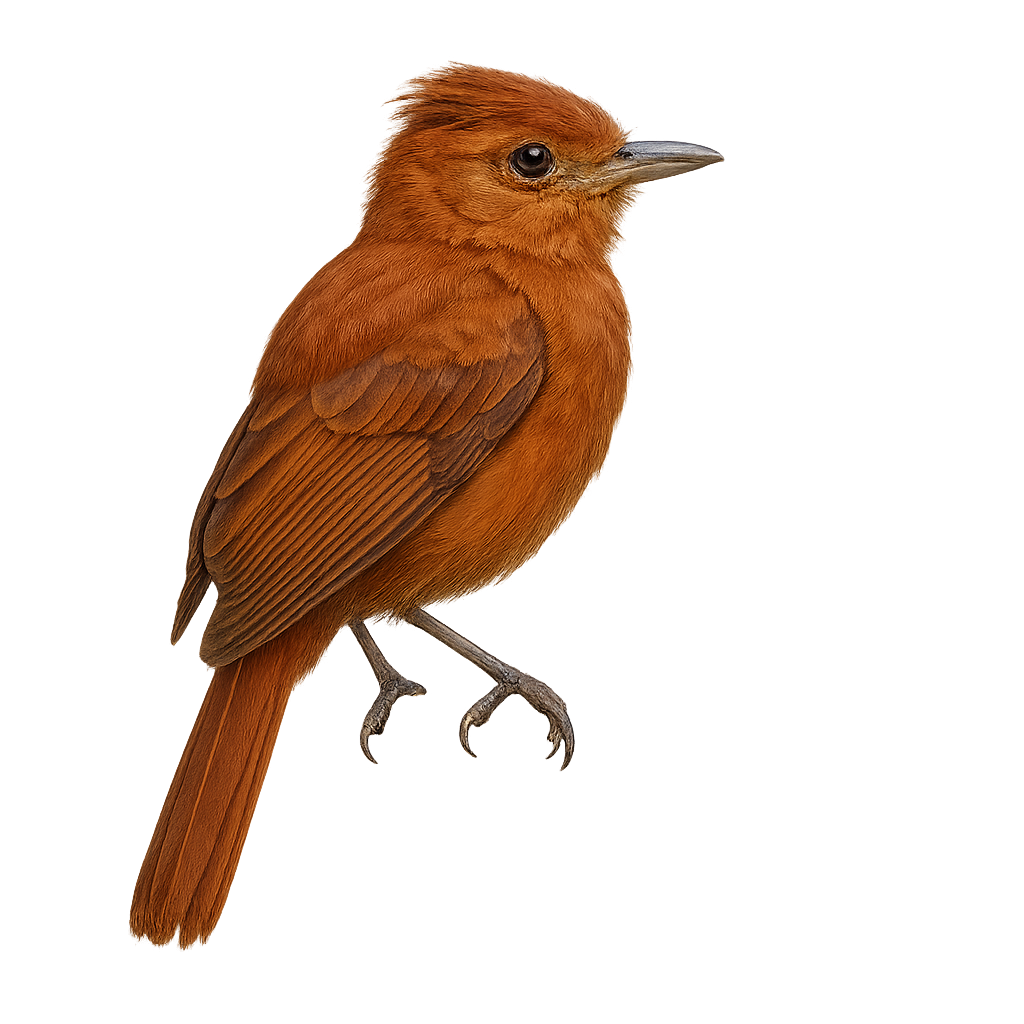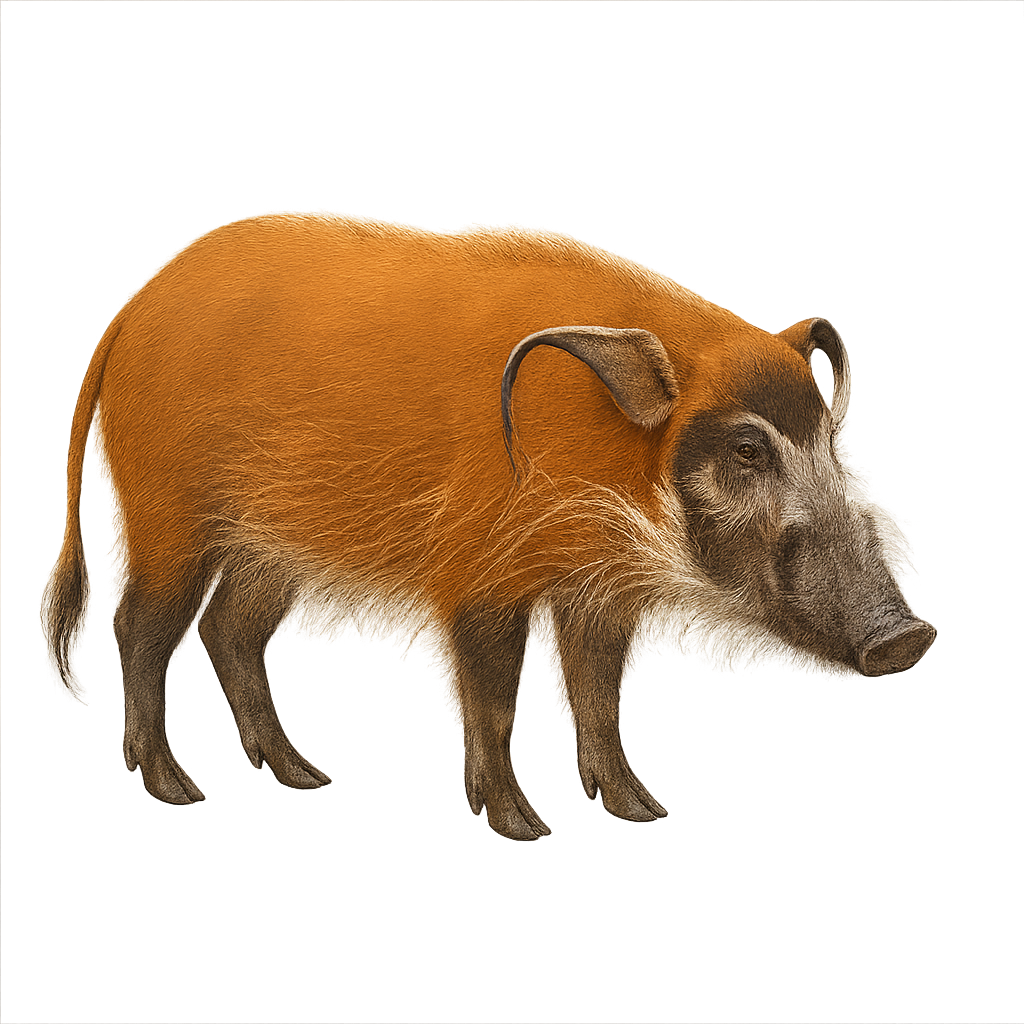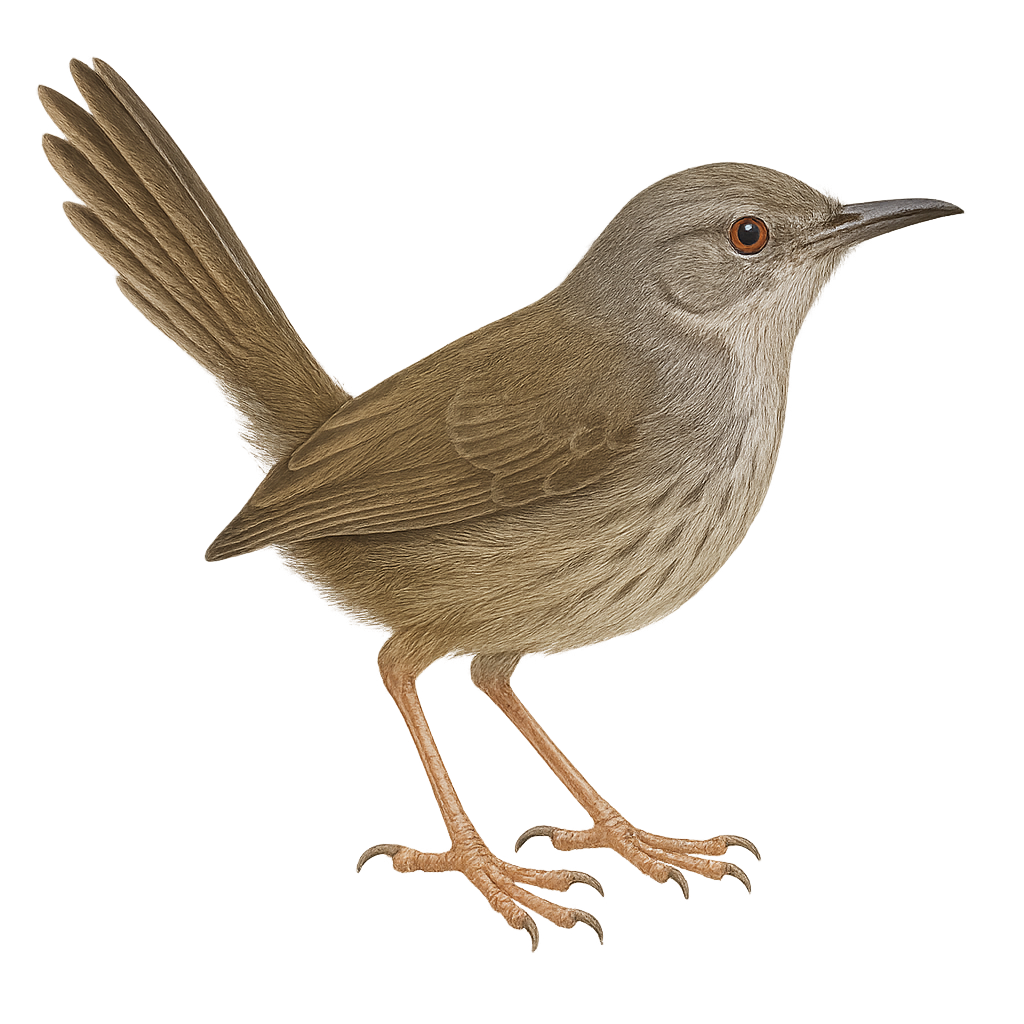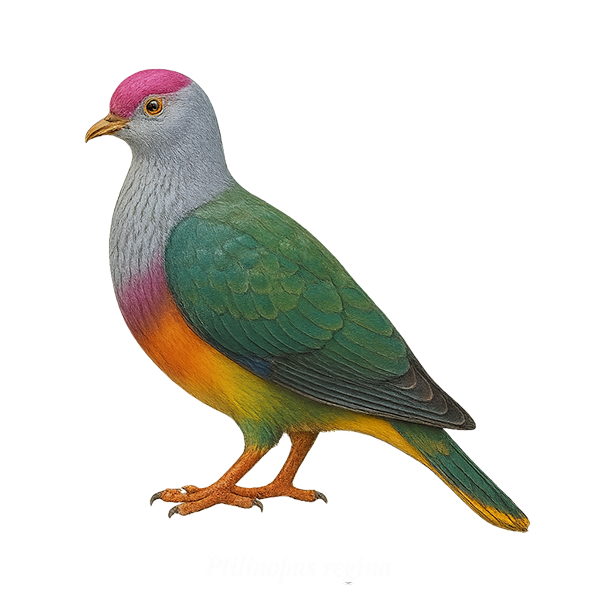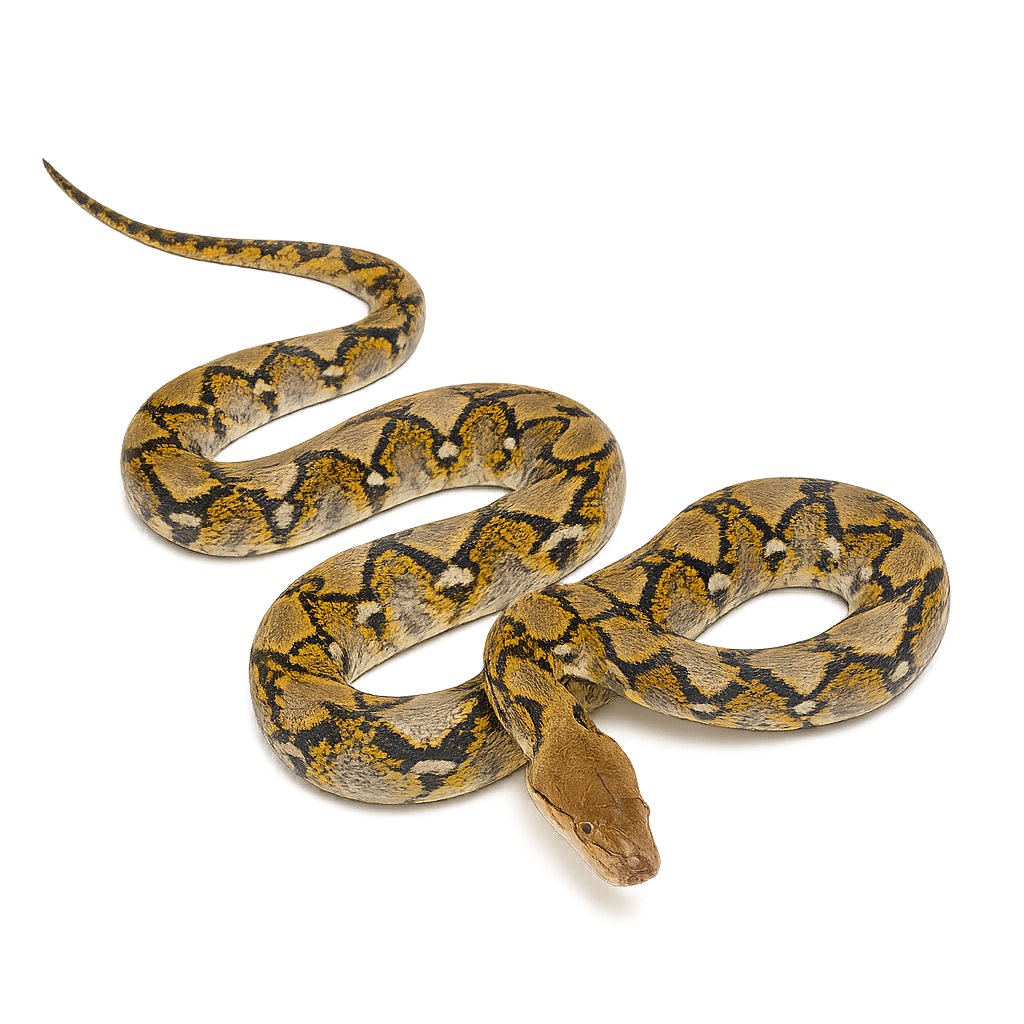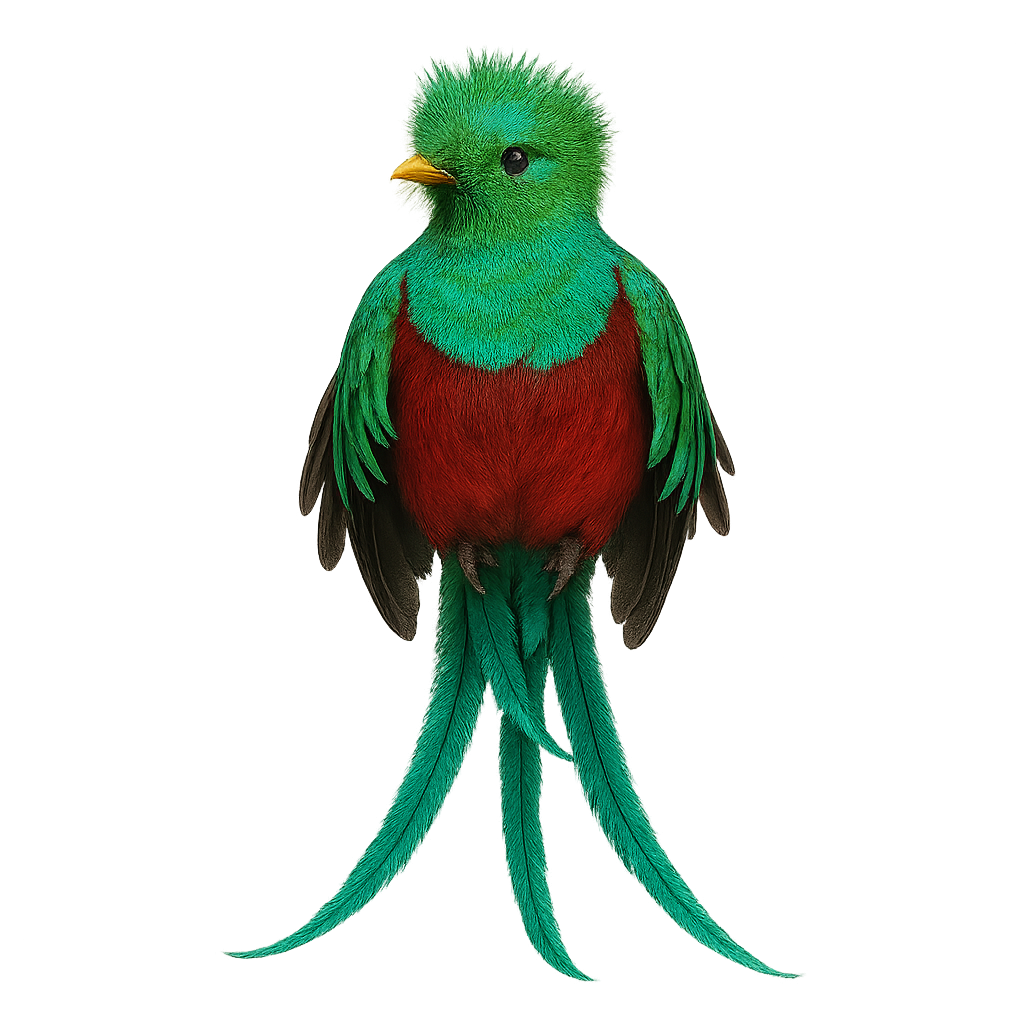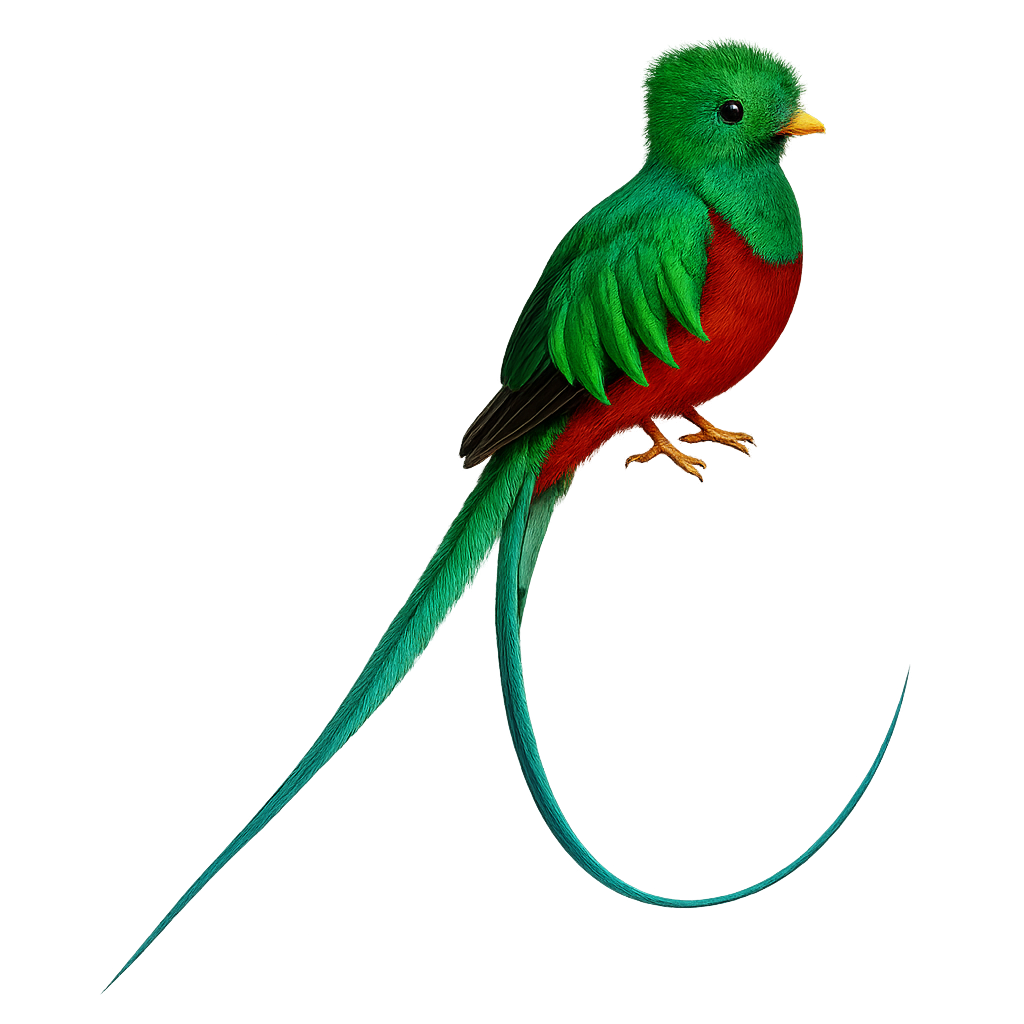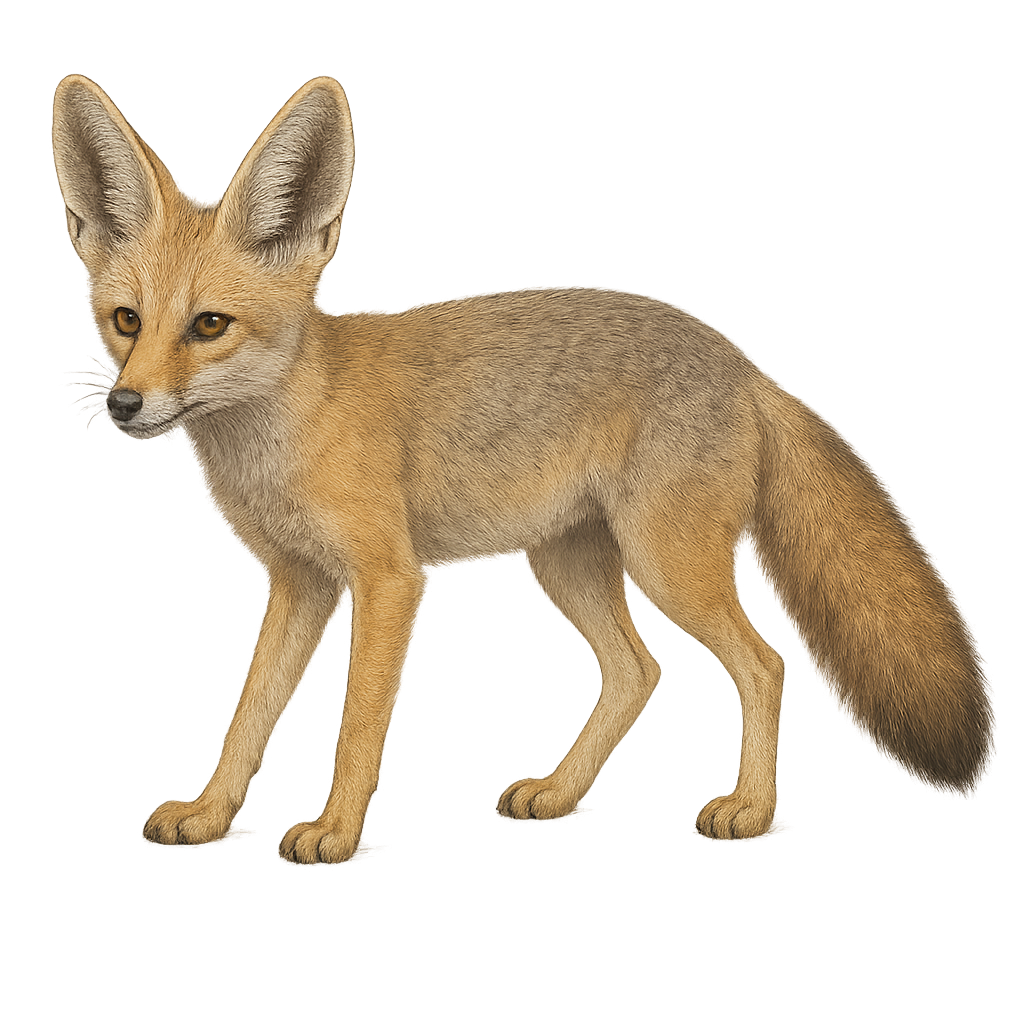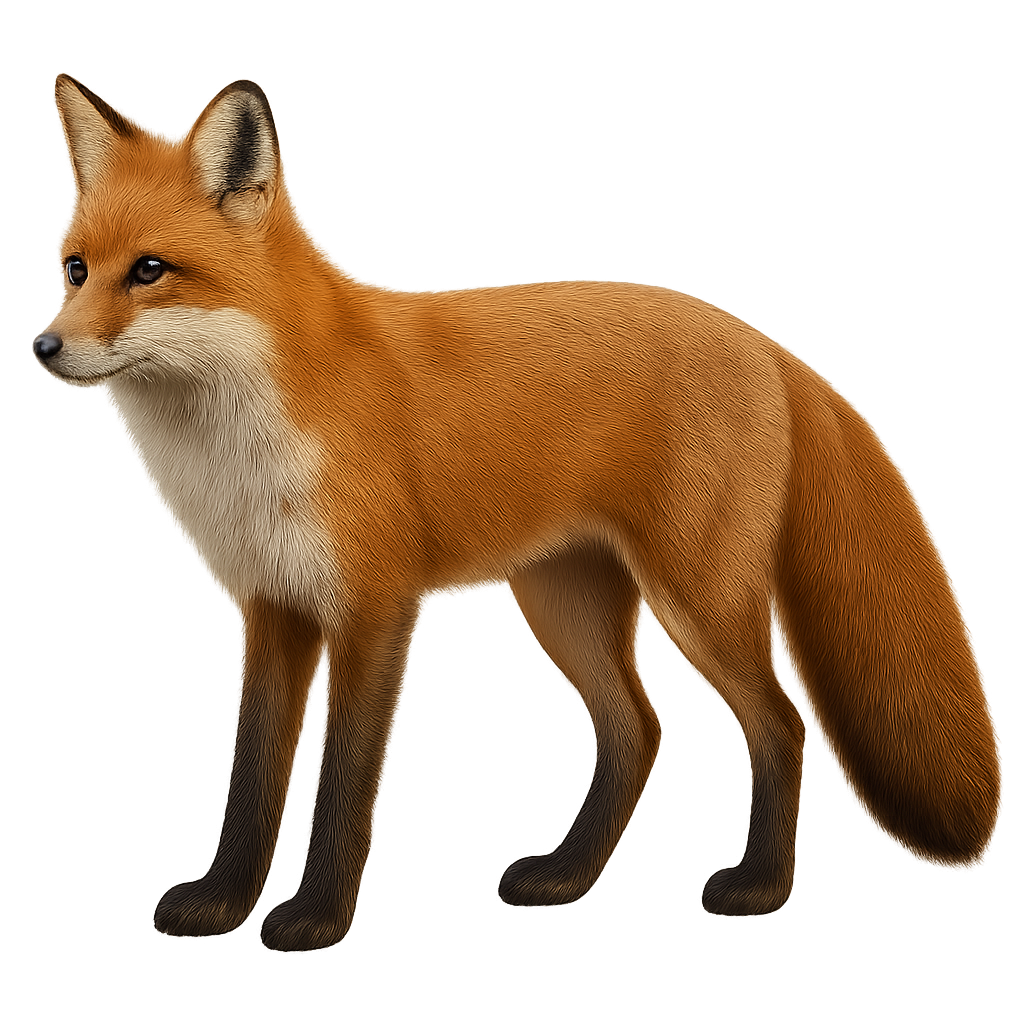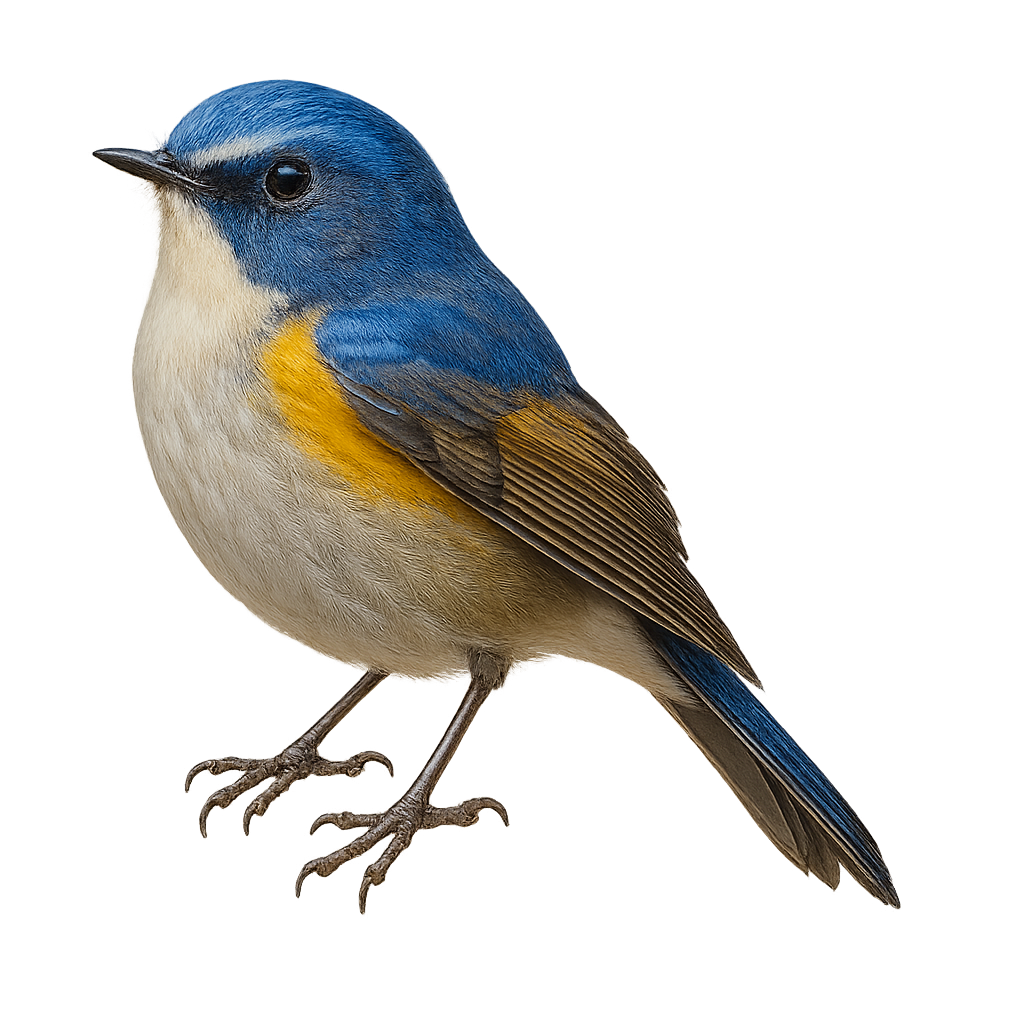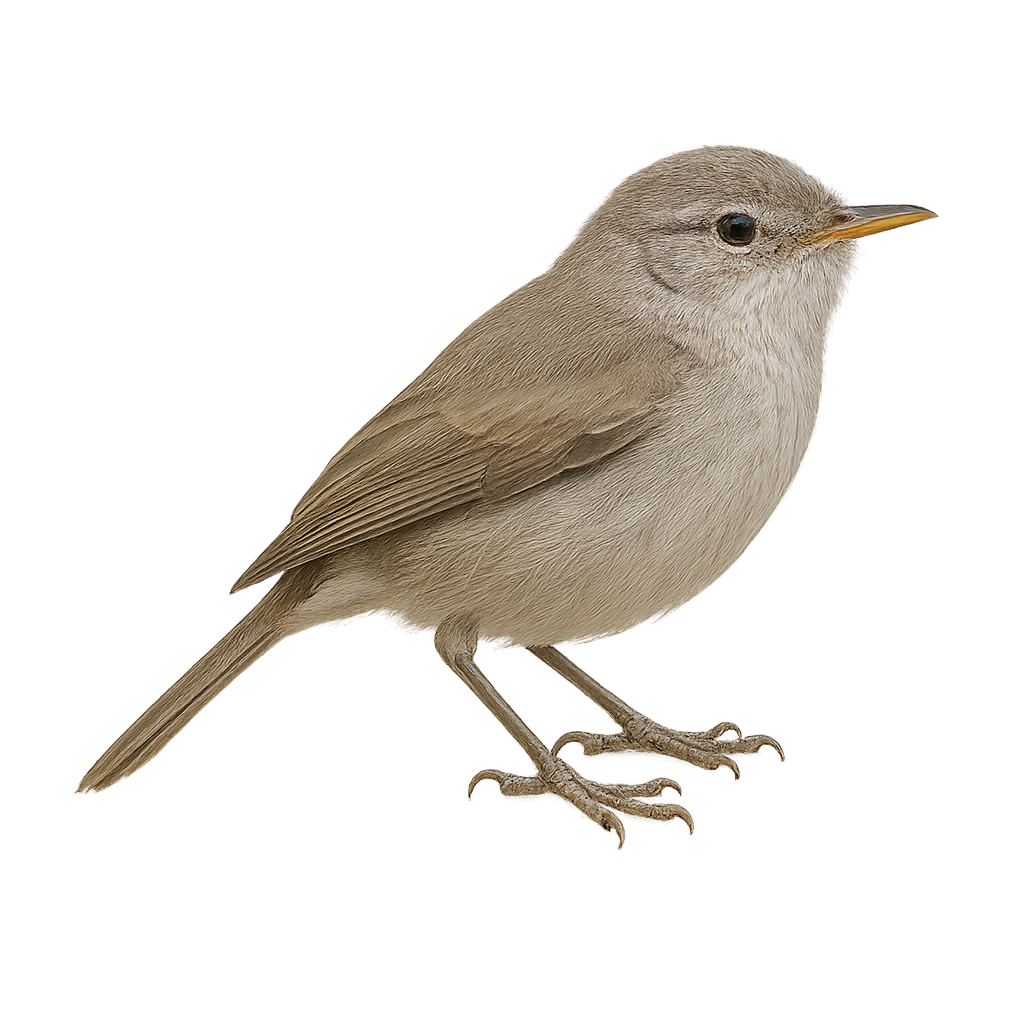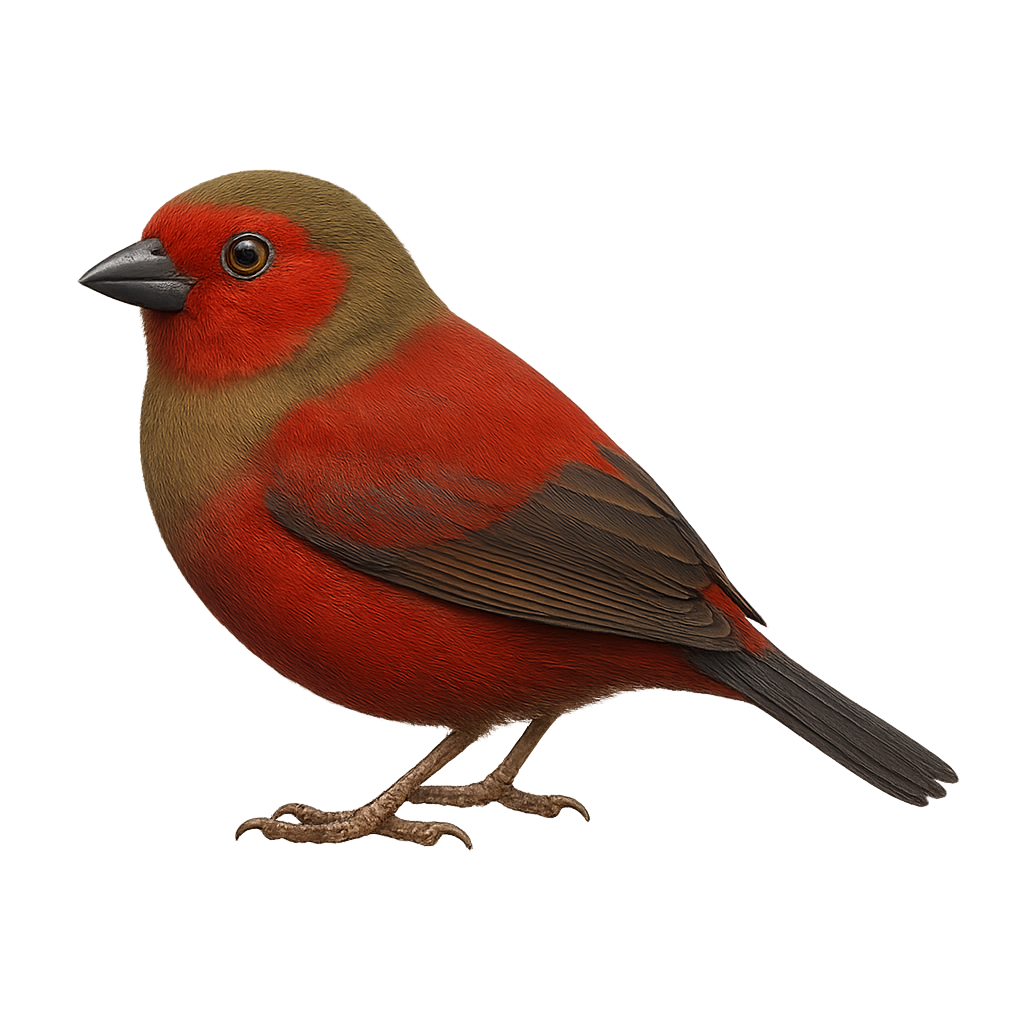The Red-stained Woodpecker, or Dryobates kirkii, is a small woodpecker known for its red and brown plumage. It primarily inhabits the tropical and subtropical forests of South America, particularly in Colombia, Venezuela, and Brazil. This woodpecker is recognizable by its reddish head in males, while females have a more subdued cap. It feeds mainly on insects, which it extracts by drumming on tree bark. Although discreet, its drumming is often audible in its natural habitat. It plays a crucial role in the ecosystem by controlling insect populations and creating tree cavities that serve as nests for other species.
The Red-breasted Sapsucker, or Sphyrapicus ruber, is a medium-sized bird belonging to the woodpecker family. It is easily recognizable by its bright red head, black and white back, and pale yellow belly. This bird is primarily found along the west coast of North America, inhabiting coniferous and mixed forests. It mainly feeds on tree sap, which it extracts by drilling holes in the bark, but it also consumes insects and fruits. The Red-breasted Sapsucker is a partial migrant, moving southward in winter. It is known for its distinctive drumming, used for communication and territory marking.
The Red-headed Woodpecker, Melanerpes erythrocephalus, is a medium-sized bird easily recognizable by its bright red head, black back, and white belly. Native to North America, it primarily inhabits open forests, orchards, and wooded areas. This woodpecker is known for its territorial behavior and ability to store food, such as insects and fruits, in tree crevices. It is also an excellent acrobat, capable of catching insects in flight. Although its habitat is threatened by deforestation, it remains a relatively common species. However, its population is declining, leading to conservation efforts to protect its natural habitats.
The Red-bellied Woodpecker is a medium-sized bird, easily recognizable by its distinctive plumage. Its head is adorned with a bright red cap, while its back features a black and white barred pattern. Despite its name, the red belly is often hard to spot. It primarily inhabits deciduous forests and wooded areas in North America, feeding on insects, fruits, and seeds. Its distinctive call and drumming on trees are typical sound characteristics. This woodpecker is a sedentary bird, although it may move slightly depending on food availability.
The Rufous-breasted Piculet is a small bird from the Picidae family, primarily found in the tropical and subtropical forests of South America. It is characterized by its rufous-brown belly and black-and-white patterns on its back and head. Measuring about 10 cm in length, it is one of the smallest members of its family. Its short, pointed beak is well-suited for its diet, which mainly consists of insects and larvae found by pecking at tree bark. Often seen in small groups or pairs, it moves nimbly through dense foliage. Though discreet, its high-pitched, repetitive call makes it identifiable to those who listen closely.
The rose-colored shrike is a small predatory bird found primarily in bushes, hedgerows, and open fields across Europe, the Middle East, and Central Asia. It is easily recognized by its light gray plumage, reddish head, and strong, hooked beak. This bird primarily feeds on insects, small birds, and rodents, which it captures by ambush and sometimes impales on branches with its beak. It is also known for its territorial behavior and constant vigilance.
The Red-backed Shrike is a medium-sized bird primarily found in hedgerows, scrubland, and open meadows across Europe and Asia. It measures about 20 to 23 cm in length and weighs between 40 and 50 g. Its plumage is characterized by a silvery-gray head, a brown back, and a whitish breast. It also has a distinctive black stripe running through its eyes. The Red-backed Shrike is an excellent hunter, primarily feeding on small birds, insects, rodents, and sometimes small reptiles. It is known for its "impaling" behavior, where it spikes its prey on thorns or barbed wire to store it. While its population remains stable in some regions, it can be threatened by habitat loss, the destruction of hedgerows, and the intensification of agriculture.
The rock pigeon, or Columba livia, is a familiar bird in urban and rural environments. With typically gray plumage and iridescent neck feathers, it features two distinct black bands on its wings. Often seen in large flocks, it feeds on seeds, crumbs, and other food scraps. Highly adaptable, it thrives in various habitats, from coastal cliffs to bustling city centers. The rock pigeon is renowned for its homing ability, which humans have historically used for message delivery. Its prolific breeding, with multiple broods per year, contributes to its widespread global presence.
The Red-throated Pipit is a small migratory bird belonging to the Motacillidae family. It is easily recognizable by its reddish throat, which is particularly visible in males during the breeding season. This passerine measures about 14 to 15 cm in length, with a wingspan of 25 to 27 cm. Its plumage is brownish with dark streaks on the back and flanks, allowing it to blend effectively into its natural habitat. It primarily inhabits tundras and wet meadows in summer, while migrating to warmer regions in winter, notably in Africa and South Asia. Its song is a melodious trill often heard in the vast expanses where it nests.
The red-throated pipit is a small migratory passerine bird found primarily in meadows, mountains, and Arctic areas across Europe and Asia. It is easily recognizable by its streaked brown plumage, red-orange throat, and furtive movement. This bird primarily feeds on insects and seeds, which it captures by running or foraging in the grass. During the breeding season, it performs song flights, a characteristic that makes it easy to spot in its habitat.
The Rufous-bellied Flycatcher, or Mionectes rufiventris, is a small bird known for its distinctive plumage. Its rufous belly contrasts with the rest of its generally duller body. This bird is primarily found in the humid and subtropical forests of South America, where it feeds mainly on insects and small fruits. It is often seen alone or in small groups, moving nimbly through dense foliage. Although discreet, its melodious song can be heard from afar, adding a sonic touch to its natural surroundings.
The Red-headed Tanager, or Piranga erythrocephala, is a vibrant bird found mainly in the mountainous forests of Mexico. This passerine is notable for its bright red head, which contrasts with its yellow-green body and dark wings. Males display more vivid colors than females, who have a duller hue. They primarily feed on insects and fruits, which they find in the forest canopy. Their song is melodious and varied, often heard during the breeding season. Although their habitat is relatively restricted, they are not currently considered threatened. However, deforestation could pose a long-term risk to their populations.
The Red-billed Blue Magpie, or Urocissa erythroryncha, is a striking bird known for its vibrant plumage and long, bright red bill. It is primarily found in the forests of the Himalayas and wooded areas of Southeast Asia. This bird is easily recognizable by its vivid blue feathers, long tail, and black and white wings. The Red-billed Blue Magpie is a social bird, often seen in small groups. It feeds mainly on insects, fruits, and small vertebrates. Its song is varied and melodious, making it a favorite among birdwatchers. Although generally wary of humans, it may approach human settlements in search of food.
The Rufous Twistwing, or Cnipodectes superrufus, is a rare and elusive bird found in the tropical rainforests of South America, primarily in southeastern Peru and northern Bolivia. This passerine is notable for its striking rufous chest, contrasting with its brown back and darker wings. It is often difficult to spot due to its discreet behavior and dense habitat. The Rufous Twistwing feeds mainly on insects, which it catches in flight with remarkable agility. Its breeding period is not well documented, but it is believed to coincide with the rainy season when food is plentiful. This bird is currently classified as near threatened due to increasing deforestation in its natural habitat.
The Red-throated Diver is a seabird found primarily in the cold waters of the North Atlantic, particularly in Northern Europe and Canada. It measures about 50 to 60 cm in length, with a wingspan of 80 to 100 cm, and weighs between 1.5 and 2 kg. Its plumage is primarily gray and white, with a dark back and a light breast. The Red-throated Diver is an excellent diver, primarily feeding on fish and crustaceans, which it catches by diving underwater. It has well-adapted legs for swimming and spends a significant amount of time foraging for food at sea. While its population remains relatively stable, this species is vulnerable to human disturbances and marine pollution.
The red river hog is a mammal from the suid family, recognizable by its reddish coat and ears adorned with long white tufts of hair. It is mainly found in the forests of Central and West Africa. This suid is omnivorous, feeding on roots, fruits, small animals, and insects. It lives in family groups led by a dominant male. Red river hogs are known for their ability to swim and navigate aquatic environments. Their behavior is generally suspicious of humans, although they can become accustomed to their presence in protected areas.
The Rufescent Prinia is a small passerine bird belonging to the Cisticolidae family. It is mainly found in the tropical and subtropical regions of Southeast Asia. Its plumage is generally brown with rufous shades on the throat, giving it its name. It measures about 13 to 14 cm in length and weighs between 6 and 10 grams. This bird is often seen in dense bushes, grasslands, and wetlands, where it primarily feeds on insects. The Rufescent Prinia is known for its melodious and repetitive song, often heard at dawn and dusk. It is a sociable bird, living in small groups and building ball-shaped nests in shrubs.
The Rose-crowned Fruit Dove is a colorful and fascinating bird native to the tropical forests of Australia and New Guinea. This medium-sized bird, measuring about 22 cm, is distinguished by its bright green plumage, vivid pink crown, and yellow belly. Males and females are similar, although males often have more vibrant colors. They primarily feed on fruits, playing a crucial role in seed dispersal. Their soft and melodious call resonates through the dense canopy. Although generally discreet, they can be observed in small groups, especially during the breeding season.
The Reticulated Python is one of the most impressive and longest snakes in the world, growing over 7 meters in length. It is easily recognized by its complex mesh pattern on its skin, which gives it its name. Native to the tropical forests of Southeast Asia, this python is primarily terrestrial, although it is also capable of climbing trees. It typically hunts mammals and birds, using its constriction power to capture and suffocate its prey. Although generally discreet, it can be dangerous when threatened.
The Resplendent Quetzal is a colorful bird primarily found in the cloud forests of Guatemala and Mexico. It measures about 35 to 40 cm in length, with a wingspan of 50 to 60 cm, and weighs between 200 and 300 g. Its plumage is bright green with a vivid red throat and a long tail composed of elongated feathers. The male is particularly spectacular, with more colorful plumage and a distinctive crest. The Resplendent Quetzal is frugivorous, primarily feeding on fruits, berries, and small insects. It is also an important symbol in Mayan culture, representing freedom and the beauty of nature. Although its population is declining, primarily due to deforestation and poaching, this species remains protected in certain regions.
The Resplendent Quetzal is a magnificent bird primarily found in the tropical and subtropical forests of the southwestern United States, Mexico, and Central America. It measures about 30 to 40 cm in length, with a wingspan of 50 to 60 cm, and weighs between 100 and 150 g. Its plumage is a vibrant green, with a vivid red throat and a long tail composed of elongated and brilliant feathers. The male is particularly spectacular, with even more colorful plumage and a distinctive crest. The Resplendent Quetzal is primarily frugivorous, feeding on fruits, berries, and small insects. This bird is also an important symbol in the indigenous cultures of the region, representing beauty and freedom. While its population remains relatively stable, this species is still vulnerable due to deforestation and habitat loss.
The Red-eyed Tree Frog is a small arboreal frog primarily found in the humid tropical forests of Central and South America, particularly in Costa Rica and Panama. It measures about 5 to 7 cm in length and weighs between 10 and 20 g. Its body is generally green, with yellow or blue spots on the sides, and its eyes are bright red, making it a particularly recognizable species. The Red-eyed Tree Frog is insectivorous, primarily feeding on flying insects like mosquitoes and flies. It is nocturnal and spends the day hidden in foliage or tree crevices. While its population remains stable in certain protected areas, it is still threatened by deforestation and pollution of its natural habitat.
The Litoria chloris, commonly known as the Red-eyed Green Treefrog, is a species of arboreal frog native to Australia. It is distinguished by its bright green color and characteristic red eyes. Measuring between 4 and 7 cm, it has webbed feet that allow it to leap agilely from tree to tree. This species is primarily nocturnal and feeds on insects, which it captures with its sticky tongue. It inhabits tropical rainforests, often near water bodies. The green tree frog plays a crucial role in the ecosystem by regulating insect populations. Although currently classified as "least concern" by the IUCN, deforestation and climate change threaten its natural habitat.
The Rüppell's fox, or Vulpes rueppellii, is a small desert-dwelling canid found primarily in North Africa and the Middle East. It is characterized by its sandy-colored fur, which provides excellent camouflage in its arid habitat. Its large ears not only enhance its hearing but also help dissipate heat. This fox is nocturnal, avoiding the extreme daytime temperatures. It primarily feeds on small rodents, insects, and fruits. Adapted to harsh conditions, it can survive with minimal water, obtaining necessary moisture from its food. Its ability to dig deep burrows offers protection from heat and predators.
The Red Fox is a small carnivore primarily found in forests, meadows, and agricultural areas of Europe, Asia, and North America. It measures about 45 to 90 cm in length, with a tail of 30 to 50 cm, and weighs between 3 and 10 kg. Its fur is typically reddish with white underparts and on the legs, and its tail is bushy with a white tip. The Red Fox is an opportunistic and omnivorous animal, feeding on small mammals, birds, insects, fruits, and berries. It is primarily active at dusk and night. While its population remains relatively stable in many regions, it can be threatened by habitat loss, vehicle collisions, and diseases.
The Rio Madeira poison frog, Adelphobates quinquevittatus, is a small, brightly colored frog native to the rainforests of South America, primarily in Peru and Brazil. Known for its distinctive stripes, usually black and yellow, this species thrives in the humid, shaded areas of tropical forests, feeding on insects and other small invertebrates. Like many poison dart frogs, it secretes potent toxins through its skin, serving as an effective deterrent against predators. It is often found near streams or ponds, where it lays its eggs. The tadpoles develop in water before transforming into adult frogs.
The Tarsiger cyanurus, commonly known as the Red-flanked Bluetail, is a small passerine bird from the Muscicapidae family. It is distinguished by its vibrant plumage, with rufous flanks and a blue tail in males, while females have more subdued tones. This migratory bird primarily inhabits coniferous forests and dense undergrowth in Eurasia. It is often seen hopping on the ground searching for insects and berries. Although discreet, its melodious song indicates its presence. Its population is stable, but it is sensitive to environmental changes, especially deforestation.
The Rodrigues Warbler, or Acrocephalus brevipennis, is a small passerine bird endemic to Rodrigues Island in the Indian Ocean. This bird is primarily recognized for its olive-brown plumage and melodious song. It inhabits the wooded areas and marshes of the island, where it feeds mainly on insects. The Rodrigues Warbler is critically endangered, mainly due to deforestation and habitat loss. Conservation efforts are underway to protect this unique species, including habitat restoration and captive breeding programs.
The Reichenow's Crimsonwing, or Cryptospiza reichenovii, is a small bird belonging to the Estrildidae family. It is primarily found in the montane forests of Central and East Africa, particularly in Rwanda, Uganda, and Burundi. This bird is notable for its bright red plumage in males, while females display more subdued shades of brown and red. The Reichenow's Crimsonwing is a discreet bird, often observed in small groups or pairs. It feeds mainly on seeds and insects, which it finds in leaf litter or on low branches. Although its habitat is relatively stable, deforestation poses a potential threat to its populations.


